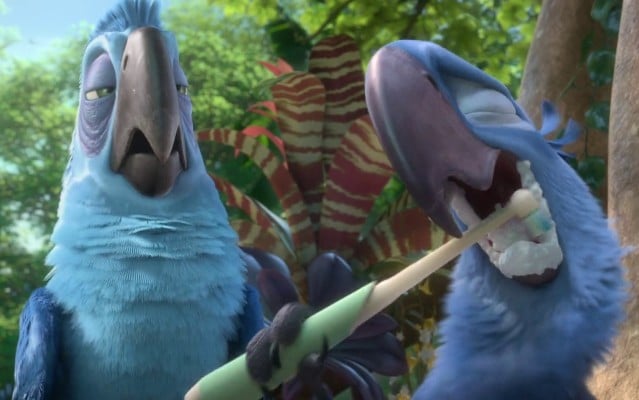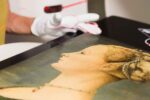Sam Lipp / Jessica Sanders

Mostra doppia personale di Sam Lipp dal titolo: “I’m An American Citizen, I Know My Rights” e di Jessica Sanders dal titolo: “Soft Poached”.
Comunicato stampa
NEOCHROME is pleased to present I’m An American Citizen, I Know My Rights, the first European solo show by Sam Lipp.
Recollections of Exotic Birds
With Sam Lipp’s exhibition I’m An American Citizen, I Know My Rights, I have been given to recollections of exotic birds. These birds, owned by my family over the last 20 years, periodically dart into my thoughts; birds, that impoverished metaphor for empty signifiers.
SL’s exhibition and the three bird stories I tell below don’t present a moral. Too often people feel entitled to resolution, and I would like neither to confine these memories, nor SL’s work to such convictions. After all, that would be missing the joke of I’m An American Citizen...: SL performs the dandy abroad, reflecting language’s paranoid power to exoticize in the dark humor of his American impetuousness. So, rather than a parable of the cage, we have decorum: there are paintings in the shape of car windows (scratchy pixelated pictures of Chicago’s martial South Side1); there might be a toilet-paper-mache sculpture of Olaf2 (a puerile symbol of cartoon queerness); and, taped to the floor, there are inkjet prints of screen captures from Rio 23.
The dandy is a figure, who, like birds, absorbs bourgeois culture and affects its meaninglessness as a perversion of instinct. This inheritance, through SL’s work, also suggests a hostile attitude, an ironic air of ineffectual labors. As might be found in my recollections, when a bird is free, it’s free to cover everything in shit; and in I’m An American Citizen... an artist’s freedom of movement is a decorous reminder of how morose our bourgeois habits are - hygiene, travel, consumption, self-identification, and indeed art among them. Abject attitudes are but reminders, topographies of unnourishing habitats. That we are ever so crude, we shit and become shit when we believe in our confinement. A last note: almost all of the bird’s in these stories died prematurely.
Chirpy
For the better part of my life, I lived in one half of a duplex that my parents owned. We depended on the rent from the other half and the four of us shared our portion of the building with our pets. My parents’ incomes wavered, but for a few years in my early adolescence, we were comfortable. It was around this time that the number of dogs increased from one to two; my sister was convinced by a bunny; and to my surprise, my parents returned from an errand with a parakeet. It was also at this time that my parents hired a cleaning woman. She came twice a month, spoke to whomever was in the room (I suspect just to avoid the loneliness of job), and the house smelled clean and looked well kempt until her next visit. Animals are antagonistic to a hygienic home and requisite to their increased membership in our household was a cleaning woman. I suppose comfort can sometimes lead to confidence; my parents tread in the exotic aisle of the pet store.
Certainly, if a bird’s cage is not cleaned appropriately, the air changes; but Chirpy also suggested levity, effortlessness, and vulnerability. A cage was necessary to contain and protect these qualities. Remember, Clinton was in office; there was a national surplus. Hopes appeared secure, investments well tended, fear and anticipation abated by a much wider, cleaner, better stocked buffer in the shape of a house. Cliches of the middle class are not written by these things, rather, they state them as fact. But birds make light of our symbols; they’re graceful when they shit on our shoulders.
Our cleaning woman was generally thorough, but unless we told her, she did not open the windows. One day, the air in our house was stifled with the inescapable ammoniac scent of PineSol. The cleaning woman was only responsible for pet waste in the areas we shared. It’s not difficult to see, then, why it was personally dismaying when we discovered Chirpy’s cage covered in shit and a dead bird. It could’ve been that Clinton was on trial at this time - I don’t remember. If some level of guilt or blame lingered, the cleaning woman still continued to come. How birds help make captivity seem willful. So, we immediately buried Chirpy in the yard and bought another parakeet.
Cookie
Two parakeets later, there was Cookie. It was a miserable green bird with a black head. It only liked my mom, but chewed all the buttons from her shirt. It drew blood with her bites and pierced my sister’s ear and my dad’s nose. Cookie detested its cage, preferring to cause chaos in the house. It was a Conure, whatever that is, and it flew away.
What is sad about Cookie is not sad about the bird itself. It was an animal that never learned to like the indoors. Interiors are about trust and surfaces. Solid walls are a supposition. Do birds pretend? My mom trusted Cookie to stay on her shoulder when she went outside.
Those are the main details about Cookie. To protect it from the dogs - who would snip at the bird when she was within range my mom chose not to clip its wings. Captivity and dogs, these were not the only things that harried this creature. Even a bird like Cookie, who was supposed to be able to imitate human speech, only let out a relentless, rebellious squawk. I didn’t blame it for flying away. I was seventeen and with the ruthlessness of a teenager, I was more sympathetic to the bird. Even if from a mistaken trust, my mom gave Cookie its freedom.
Dusty
Of all my family’s birds, there was one I loved. I’d prefer to keep this recollection brief. It was subject to the same fate as all my family’s birds; and it causes me pain to think that memories become such cheap metaphors set against the banalities of their history and context. Dusty was in my life briefly, but during a torrent of depression and panic. The bird distracted my attention by carving tunnels through the blankets that covered me in my state of physical and emotional inertia. It’d fly out one end of its chamber, surprise me, and seem to take joy in doing so. Dusty exuded a completely unself-conscious charm, an animal characteristic that, despite whatever type of bird it was, made one want to read kindness and intelligence in her behavior. But, as I said above, memories, like hand-feeding a bird into happy captivity, are manipulated by language. Hence, if her ironic fate leaves me cold (a pun I won’t share), it is an equally valid symbol. As any of these near-moralistic reflections show, it’s not the bird, but the odd, hapless, and availing humors with which one keeps them. I suppose it has at least been nice to recollect my family’s birds.
- Sam Korman, March 2015
1 Chicago’s South Side is one of the most notorious urban areas in the United States. Despite a borderline police state, it has one of the country’s highest murder rates. SL is also a recent Chicago resident.
2 Olaf is a character in the Disney film, Frozen released in 2013. The movie uses climate change as a backdrop for a fairytale romance. Olaf, the snowman, along with other parts of the film, were heavily debated for representing a gay subplot, with Olaf occupying the stereotypical position of gay best friend for the princess.
3 Rio 2, released in 2014, is a digitally animated children’s movie. The film follows a family of parrots’ trip to the Brazilian Amazon, as they struggle to reconcile their life in America with their origins in the tropical rainforest. As with Frozen, this film uses highly contested issues such as climate change and immigration as the backdrop for a fantasy about self-discovery and -realization. The film casts Latino actors in the roles of exotic animals and white actors in the role of the American birds. The title of this exhibition is a line delivered by the film’s parrot protagonist.
NEOCHROME è lieta di presentare Soft Poached, la prima personale europea di Jessica Sanders.
Da sempre affascinata dai materiali malleabili di origine naturale (il suo MFA in ceramica alla Ohio State University testimonia tale propensione), negli ultimi sette anni Jessica Sanders ha dato vita ad un immaginario multimediale ove abitano installazioni, sculture, dipinti, tutti caratterizzati dall’impiego di tre medium principali: la cera, il lino e il legno.
In Soft Poached, le proprietà della cera sono esplorate e continuamente messe alla prova tramite un processo manipolativo per alcuni aspetti inatteso. Basti pensare alla serie Saturation, che ritrae molteplici “copie” di un medesimo pattern; il gesto iterativo dell'artista lascia intendere quale sia l'immagine ideale che funge da premessa, ma il modo in cui la cera fusa viene assorbita dal lino genera delle leggere discrepanze tra le opere di eguali dimensioni. Emerge dunque una reale consapevolezza del corpo dell’artista tramite la corporeità della cera, rimarcata in chiave intima dalla scelta del lino e del tessuto batista.
Presentata per la prima volta in uno spazio espositivo, la serie Cast, Cover si compone di due entità che nascono separate e si incontrano una volta compiute: una tela immersa nella tintura ad olio e ricoperta da un solo strato di cera ospita infatti un solido calco in cera d'api che copre quasi del tutto l'area frontale del dipinto, facendone risaltare il colore della superficie laterale. Anche in questo caso, alcune piccole irregolarità della cera (il processo di essiccazione al variare della temperatura non è mai interamente prevedibile) identificano in modo inequivocabile le singole opere della serie. La natura dinamica di tale materia determina inoltre la presenza di un minimo intervallo tra le due componenti dell'opera, suggerendo un'indipendenza materica che si convalida nonostante - o forse proprio tramite - l'unione formale.
L’estremizzazione scultorea della différance intrinseca alla pratica artigianale è incarnata dalla serie Jut, anch'essa inedita. Qui una forma solida di cera d'api si declina in molteplici alternative, che pur nell'unicità tradiscono la firma di una matrice. Nella sottrazione degli elementi decorativi trova quindi conferma il rigore estetico della Sanders, la cui sfida più importante si svolge all'interno del confine liminale entro il quale l'opera sfugge all'intenzione dell'artista per autodefinirsi: manipolare se stessa.
Jessica Sanders è nata nel 1985 a Mena (AK), vive e lavora a Brooklyn.
Mostre selezionate: Kansas (New York), Johannes Vogt (New York), Showroom Gallery (Brooklyn), Berthold Pott (Cologne), Middlemarch (Brussels).
NEOCHROME is pleased to present Soft Poached, the first European solo show by Jessica Sanders.
Always fascinated by malleable materials of a natural origin (her MFA in ceramics from Ohio State University bears this out), over the past seven years Jessica Sanders has produced a multimedia body of work where installations, sculptures and paintings coexist, all of which are considered through the filter of materials: beeswax, linen, and wood.
In Soft Poached, properties of wax are explored and constantly tested through an unexpected process of manipulation. In a new iteration of the Saturation series, Sanders is concentrating on one individual form to produce multiple copies of a single pattern. This reiterative gesture implies a standard image that functions as a premise, but the unpredictable nature of the process and the way in which the melted wax is absorbed by the linen generates discrepancies between works. What emerges is an awareness of the artists body within the process and the corporality of wax, underlined in an intimate way by the choice of the suiting linen and batiste fabrics.
Presented for the first time in an exhibition space, the Cast, Cover works are composed of a cast face on stretched linen. Again in this case, certain small irregularities of the wax (resulting from fine variations in wax and room temperature) unmistakably distinguish the various works of the series. Two versions are shown - a gradient and a delaminated face. For the gradient, the face is cast at an angle, allowing the beeswax to move from translucent to opaque across the piece. For the delaminated configuration, stretched linen is dipped in a single layer of beeswax, then a solid beeswax cover is cast atop it. The cast face is made as a unified part of the piece, but the nature of the wax is to push apart from itself. The result is a small gap where the two parts meet, suggesting a material independence that asserts itself in spite of – or perhaps through – the formal union.
The sculptural exasperation of the différance intrinsic to an artists’ practice is embodied by the Jut series, also shown for the first time. Here a solid beeswax work is produced in multiple variations of the same form. Each piece is unique yet reveals the signs of a mold, contrary to but still acknowledging the norms of the process through which its made. The subtraction of decorative elements confirms the aesthetic rigor of Sanders, whose main challenge unfolds inside the liminal threshold in which the work eludes the artist’s intentions and starts to define itself: to manipulate itself.
Jessica Sanders was born in 1985 in Mena (AK), lives and works in Brooklyn.
Selected exhibitions: Kansas (New York), Johannes Vogt (New York), Showroom Gallery (Brooklyn), Berthold Pott (Cologne), Middlemarch (Brussels).
Sam Lipp was born in 1989 in UK, lives and works in New York.
Selected exhibitions: Bodega (New York), Malraux's Place (Brooklyn), Nosbaum Reding (Luxemburg).



